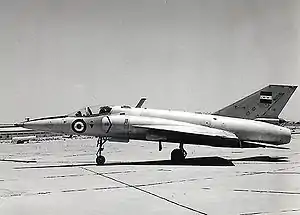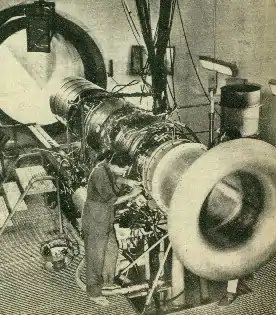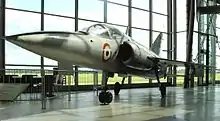Helwan HA-300
The Helwan HA-300 (Arabic: حلوان ٣٠٠) was a single-engine, delta-wing, light supersonic interceptor aircraft developed in Egypt during the 1960s. It was designed by the German aircraft designer Willy Messerschmitt.
| HA-300 | |
|---|---|
 | |
| Role | Single-seat interceptor |
| National origin | Egypt |
| Manufacturer | Egyptian General Aero Organisation |
| Designer | Willy Messerschmitt |
| First flight | 7 March 1964 |
| Status | Cancelled |
| Primary user | Egyptian Air Force |
| Produced | 1964–1969 |
| Number built | 7 |
At various stages, Spain and India were involved in the development program. Spain was financing two projects, the HA-200 and the Hispano HA-300, but cancelled the HA-300 project before a prototype was built due to overruns. Egypt then took over financing, and the program was transferred to Egypt where both it and its engine would be made, and where the aircraft was successfully flown. Near the end of the program, India began financing the development of the E-300 engine for use in the Indian HF-24 Marut jet fighter.
The HA-300 was an ambitious and costly project for Egypt, at a time when it was seeking to expand both its civilian and defence aviation industry. Six aircraft had entered service before the project was terminated in 1969.
Design and development
Origin
Following their defeat at the end of World War II, the West Germans were prohibited from undertaking any research or development related to aircraft until 1955, which left Willy Messerschmitt looking for work. He therefore moved to Spain where he joined Hispano Aviación and started designing an ultralight fighter aircraft in 1951.[1] A lack of funds slowed the aircraft's development and Messerschmitt was able to build only a delta-shaped tailless plywood glider. Towed by a CASA 2.111, the test flight for the glider was prematurely terminated due to instability and the airplane did not become airborne.[2] Due to funding problems and the resultant long development time, Spain abandoned the project in 1960.[3]

Egypt then acquired the design from Hispano Aviación. The design team, headed by Messerschmitt, moved to Helwan, Egypt, to continue its work on the HA-300, which now stood for Helwan Aircraft 300.[4] Ferdinand Brandner, an Austrian jet engine expert, was also invited to develop a turbojet for the new fighter. Egypt aimed to produce a lightweight supersonic, single-seat fighter that could join the Egyptian Air Force as an interceptor.[5]
HA-300
Development of the Egyptian HA-300 started in the test facilities and workshops in Factory No. 36 in Helwan, southeast of Cairo, under the supervision of the Egyptian General Aero Organisation (EGAO), beginning officially in 1959.
The first prototype of the HA-300, powered by a 2,200 kgp Bristol Siddeley Orpheus 703-S-10, first flew on 7 March 1964,[6] and achieved Mach 1.13.[7] Egypt sent two Egyptian pilots to India in 1964 to prepare for the HA-300 flight development.[4] It was followed by a second Orpheus-powered prototype which first flew on 22 July 1965. The third and last prototype was fitted with the Egyptian E-300 engine, which it was hoped would make it capable of attaining 12,000 m (39,000 ft) and Mach 2.0 within 2.5 min after takeoff. This prototype was flight-tested at least once when it achieved a speed of Mach 2.1 with the Egyptian Brandner E-300 engine.
A total of 135 million Egyptian pounds was spent on the development, while the E-300 engine was transferred to the Indian government for use in the HAL HF-24 Marut fighter.[8]
E-300 Engine

The HA-300 fighter was originally designed around the 8,170 lbf (36.3 kN) afterburning Bristol Siddeley Orpheus Orpheus 703-S-10 turbojet, but aside from whether the British would even release it for use by the Egyptians, President Nasser saw that being dependent on a British engine was a major threat to national security, due to the potential for an embargo to ground the aircraft thanks to continued British hostility toward Egypt following the 1956 Suez crisis when Britain, France and Israel invaded Egypt.
The HA-300 was modified for the Egyptian Brandner E-300 engine, whose planned output was to have been 10,600 lbf (47.2 kN) of thrust on afterburner, which would also improve the HA-300's performance. India assisted in funding its development in exchange for their use of it as the powerplant for their HF-24 Marut.[4] The E-300 ran successfully for the first time in July 1963.[3]
Termination
The Helwan-300 project was cancelled on May 1969. The reason was not publicly stated but financial and political factors likely played a part. The German engineers working on the design were forced to leave Egypt after receiving multiple death threats from the Israeli Mossad. In order to fill the now vacant role, Egypt established close contacts with the Soviet Union and purchased Soviet aircraft instead of continuing to develop indigenous designs.[1][5]
Aircraft on display

- The first HA-300 prototype has been on display in the Deutsches Museum Flugwerft Schleissheim at Oberschleißheim near Munich since 1997. It was bought by Daimler-Benz Aerospace AG (DASA) and restored at Manching by MBB over a five and a half year period.[4]
- One HA-300 is displayed by the Messerschmitt Stiftung in Manching.
Specifications (HA-300 with Orpheus 703 engine)

Data from Deutsches Museum Flugwerft Schleissheim,[9] theaircache.com,[10]
General characteristics
- Crew: One
- Length: 12.40 m (40 ft 8 in)
- Wingspan: 5.84 m (19 ft 2 in)
- Height: 3.15 m (10 ft 4 in)
- Wing area: 16.70 m2 (179.8 sq ft)
- Airfoil: Biconvex 3%[11]
- Empty weight: 2,100 kg (4,630 lb)
- Gross weight: 5,443 kg (12,000 lb)
- Powerplant: 1 × Bristol Orpheus 703-S-10 (first two prototypes) turbojet, 21.6 kN (4,900 lbf) thrust dry, 36.3 kN (8,200 lbf) with afterburner
- Powerplant: 1 × Brandner E-300 (third prototype) turbojet, 32.4 kN (7,300 lbf) thrust dry, 47.2 kN (10,600 lbf) with afterburner
Performance
- Maximum speed: 2,100 km/h (1,300 mph, 1,100 kn) Mach 2.1 with Brandner E-300 engine
- Maximum speed: Mach 1.7
- Range: 1,400 km (870 mi, 760 nmi)
- Service ceiling: 18,000 m (59,000 ft)
- Rate of climb: 203 m/s (40,000 ft/min)
- Wing loading: 125.749 kg/m2 (25.755 lb/sq ft)
- Power/mass: 0.88
Armament
- Guns: 2 × 20mm Hispano or 4 × 23mm Nudelman-Rikhter NR-23 cannon
- Missiles: 4 × K-13 infrared homing air-to-air missiles
See also
Aircraft of comparable role, configuration, and era
Related lists
References
| Wikimedia Commons has media related to Helwan HA-300. |
Citations
- "Hispano Aviácion HA 300". EADS. 20 July 2008. Archived from the original on 26 June 2007. Retrieved 18 August 2008.
- Schick, Walter; Radinger, Willy (2004). Messerschmitt-Geheimprojekte : [Studien, Projekte und Prototypen für einstrahlige Jagdflugzeuge : Meilensteine auf dem Weg zum modernen Kampfflugzeug] (in German) (3. Aufl. ed.). Oberhaching: AVIATIC-Verl. pp. 149–150. ISBN 978-3925505140.
- Ace (10 December 2006). "The Egyptian Helwan HA-300". Aviation fans. Archived from the original on 17 September 2008. Retrieved 8 August 2008.
- Group Captain Kapil Bhargava. "Messerschmitt's HA-300 and its Indian Connection". MEMOIRS. Indian Air Force. Archived from the original on 5 July 2008. Retrieved 8 August 2008.
- Bahaa, Mohamed (28 November 2007). "Helwan-300: The Egyptian Interceptor Project". Aviation Articles. e-sac. Archived from the original on 17 February 2008. Retrieved 8 August 2008.
- Bhargava, Group Captain Kapil. "Eyewitness to the Six-Day War". The Sixties. Indian Air Force. Archived from the original on 4 July 2008. Retrieved 9 August 2008.
- "Helwan HA-300". Flug revue. 14 July 1998. Archived from the original on 4 July 2008. Retrieved 9 August 2008.
- "Helwan HA-300". globalsecurity.org. Retrieved 29 January 2016.
- "Hispano Aviacion HA-300". Deutsches Museum Flugwerft Schleissheim. Deutsches Museum. Archived from the original on 14 April 2015. Retrieved 14 October 2014.
- Guilfoil, John M. (13 July 2012). "HA-300". Air Cache. Retrieved 14 October 2014.
- Lednicer, David. "The Incomplete Guide to Airfoil Usage". m-selig.ae.illinois.edu. Retrieved 9 October 2019.
Bibliography
- Bar-Zohar, Michael. and Nissim Mishal Hirschel. Mossad: The Great Operations of Israel's Secret Service. London: Biteback Publishing, 2012. ISBN 978-1-84954-543-3
- Buttler, Tony. X-Planes of Europe II: Military Prototype Aircraft from the Golden Age 1946–1974. Manchester, UK: Hikoki Publications, 2015. ISBN 978-1-90210-948-0
- Edgerton, David. The Shock of the Old: Technology and Global History Since 1900. Madison Avenue, New York: Oxford University Press, 2011. ISBN 978-0-19-532283-5
- Hirschel, Ernst Heinrich., Horst Prem, and Gero Madelung. Aeronautical Research in Germany: From Lilienthal Until Today (Illustrated ed). Springer Science & Business Media, 2004. ISBN 3-540-40645-X